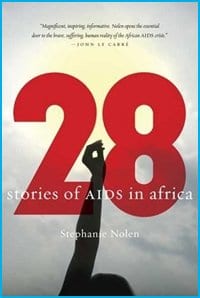Zackie Achmat went from fighting apartheid to fighting for his life. After he tested positive the gay activist formed the Treatment Action Group in 1998 to demand affordable medication for three million people living with HIV in his country. Achmat announced he would “not take expensive treatment until all ordinary South Africans can get it on the public health system.” He became a national hero.
Achmat is profiled in Stephanie Nolen’s 28: Stories of AIDS in Africa. Nolen, who identifies as queer, is the Globe and Mail’s Africa correspondent. She’s written about AIDS since 2003. Her choice of 28 stories is symbolic, representing the estimated millions of Africans living with HIV.
A moving and intelligent book, 28’s great strength is a freedom from moralism. In her introduction Nolen gives the most straightforward description I’ve read of how HIV operates in the body, how it’s believed to have first manifested among humans and the trajectory of the virus across the continent and around the world.
Blaming others is a universal aspect of the response to HIV. In North America the onset of the epidemic among queers and IV drug users was interpreted as a morality play. Many of Nolen’s interviewees express disbelief they could be touched by that “white man’s disease,” an export from America, which, at worst, was thought to affect prostitutes and the poor.
Official inaction is another common hallmark. In the US Ronald Reagan waited six years and 27,909 deaths before uttering the word “AIDS.” In Swaziland, where a third of the adult population has HIV, King Mswati has spoken out about HIV, but Nolen points out that funds he could’ve directed toward fighting the disease have instead been used “to build lavish palaces for all of his wives, then add[ing] to his luxury car collection.”
AIDS has inflicted devastation upon communities everywhere. A generation of queer men suffered an incredible loss, our institutions robbed of leaders in their prime. Across Africa the impact’s even more calamitous. Nolen speaks to Tigist Haile Michael in Ethiopia who’s raised her brother since their mother died when Tigist was 10, her brother six. In a southern Zambian village 74-year-old Regine Mamba supports more than a dozen children. “Their mothers and fathers died,” she says. In some nations government infrastructure crumbles as vast numbers of ministers and civil servants succumb.
Gender inequity drives AIDS in Africa. In many countries armies and rebel forces employ rape as an act of war. Worse, Nolen notes, soldiers use sexual assault to intentionally spread HIV to enemies — as in the Interahamwe, a genocidal paramilitary organization in Rwanda.
In war-torn areas it’s a challenge to administer or adhere to treatment, but Nolen chronicles the successful efforts of Medecins sans Frontières to get antiretro-viral drugs to people with HIV in battle zones. She also details how legal and social restrictions have fuelled the epidemic. In apartheid South Africa cheap labour was drawn from neighbouring countries to work in the dangerous mining industry but none of the workers were allowed to bring their wives. They lived in cramped men-only hostels, which drew sex workers who were poor and desperate for clientele.
Twenty-five years after the first person was diagnosed with AIDS in North America, queers can learn much from Nolen’s stories.
“In the early days of the epidemic in North America,” she writes, “when only gay men and heroin addicts had HIV it was easy to shun people with the disease: these were marginalized groups, easily isolated.”
Comparing that context to modern-day Botswana, which has the second highest prevalence of HIV in the world, she adds, “But it is far more difficult, indeed largely impossible, to isolate a third of the population, or to argue that all of those people are guilty of something.”
She makes an important point. Back in 1988 Act Up New York’s Gran Fury art collective proclaimed that, “All people with AIDS are innocent.” Times change. Today there is widespread sentiment that queer men who acquire HIV are authors of their own misfortune, that they should have known better. This notion is put forth not only by the religious right; it’s commonly articulated by other queer men.
Gay AIDS activist Douglas Crimp responds to this argument in his brilliant book Melancholia and Moralism. “I seroconverted because I am human,” writes Crimp, “and no, no one is safe, not you, your boyfriend or any of your negative friends. Because you and they are human, too.”
The men and women who populate Stephanie Nolen’s 28 came into contact with HIV in a wide variety of ways and none of them are to blame for being human. If queer men can understand this lesson through the lives of others a continent away, perhaps we can also see it in our own.

 Why you can trust Xtra
Why you can trust Xtra


